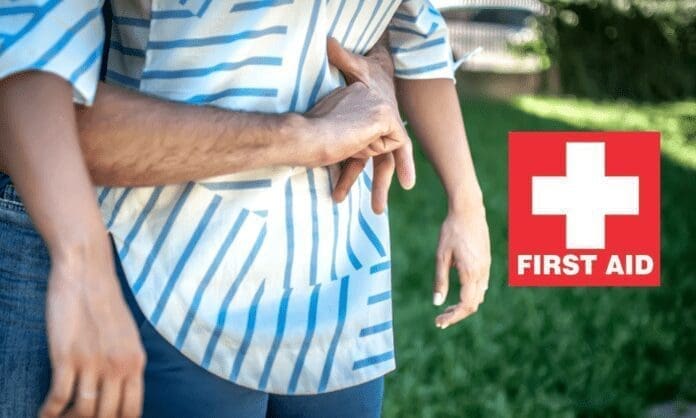First Aid training can and will help you save the life of another. Thousands of people know this fact each year when they sign up for basic first aid or CPR training certification classes.
Most taking these classes never imagine they’ll actually have to use them, let alone on a family member.
Last weekend, Rabbi Joshua Lief got to experience that potential nightmare scenario. Fortunately for Lief, his previous training and life experiences prepared him for just such an occasion
His daughter was drinking from a Dasani water bottle when she put the cap back on. As children are want to do, she was playing around and squeezed the bottle into her mouth, believing the cap was securely tight atop the bottle.
It was not. Water wasn’t the only thing that shot back into her mouth, as the cap rocketed toward the back of her throat and became lodged tight. She wasn’t breathing.
“My wife came running in, as they were about to leave to go shopping, and yellow that our daughter was choking,” Lief recalled. “I told her to call 911 and quickly did a finger sweep to see if I could clear her airway that way, but I didn’t succeed.
“So I performed the Heimlich, she coughed a little but was still choking, so I did it a second time. It spewed out whatever she ate for lunch, but not the cap.”
Lief’s daughter could now talk and, more importantly, breathe. But true, the cap had yet to be located. Might it have been lost in the shuffle? It was certainly small enough.
Ironically, a design feature that seeks to lessen the environmental impact of the bottles made it easier for Lief’s daughter to choke upon the cap.
Lief noted that the caps used to be 1-inch round in diameter, but because the caps are not one-quarter of an inch in depth, the cap could be swallowed and wedge itself in her esophagus.
A Cap’s Whereabouts
The question remainder, where was the cap?
The family searched for it all around, on the floor, under furniture, but to no avail. What the family did find, however, is that the daughter still was suffering from unusual pains in her upper chest.
The Lief family consulted with emergency medical technicians who already arrived on the scene. The general consensus? The cap was swallowed further and still in her body.
“She was having sharp pains in her upper chest and we thought maybe the cap was stuck and the EMT folks that had came agreed,” Lief said. “So we went to the hospital and they did CT imaging and determined that it was stuck.”
After a CT scan confirmed their worries, the Lief family went to WVU Children’s Hospital in Morgantown, where the piece of plastic was ultimately removed.
Thankfully with that ordeal behind them all, Lief’s daughter is on the road to recovery.
“Her throat is a little sore and they said it’d be like that for a couple of days,” Lief said. “The benefit for her is that she gets to eat ice cream, milkshakes, and slushies.
“The folks are Children’s Hospital were wonderful. The team was excellent and all had incredible bedside manners. The folks at Wheeling and the EMTs were great as well. They did everything they could and, as soon as they realized it was still stuck, they knew we needed to go to a more specialized facility.”
That’s Why We Train
This was a potentially life-threatening situation that had a happy ending. Lief’s previous training, quick thinking, and calmness in a potentially panic-inducing situation were critical.
In Lief’s younger days, both in the Boy Scouts and working as a lifeguard, he took multiple classes both in first aid and CPR, learning the Heimlich in the process.

It wasn’t the first time necessity dictated he perform the Heimlich, nor a need for Lief to spring into action to help save another’s life.
It’s that training and those experiences that allow the father of two to act on instinct when his wife pointed out the urgency of the situation with their daughter.
“I took a significant amount of first aid training over the years, so I knew what to do and was able to quickly clear her airway,” Lief said. “Fire and EMTs came very quickly, but had I not cleared her airway, she likely would have passed out and it potentially have become a lot more serious.
“I had not done it for a very long time, but on many occasions, I’d performed CPR and life-saving techniques in the past. Knowing some basic first aid and basic life-saving techniques is critical.
“It’s like the AEDs at ball fields. You can save someone’s life with it, but if you don’t have the knowledge of how to use one, it’s just a useless piece of equipment.”
Lief was a proponent of receiving first aid and associated training before the events of last weekend transpired. Safe to say he’s even more in that camp now.
Had he not received previous training, he may have frozen, even for a second or two, when he first learned that his daughter was choking. In a potentially life-threatening situation, every second counts.
“The classes I took showed me what to do and to follow through on the procedure,” Lief said. “Every situation is unique and you will never know the exact circumstances, but if you’ve been exposed and learned the training, then you will at least have the chance to deploy those. It’s worth getting yourself that knowledge.”
Lief’s daughter most likely agrees with that statement. She’s standing here today in part because of it.


